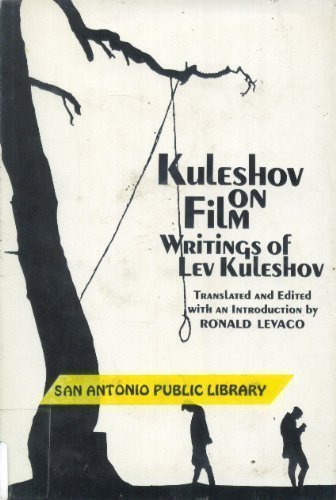Kuleshov on Film: Writings by Lev Kuleshov download
Par wimberly alan le lundi, juillet 18 2016, 14:43 - Lien permanent
Kuleshov on Film: Writings by Lev Kuleshov by Lev Vladimirovich Kuleshov, Ronald Levaco


Download eBook
Kuleshov on Film: Writings by Lev Kuleshov Lev Vladimirovich Kuleshov, Ronald Levaco ebook
Publisher: Univ of California Pr
Format: pdf
ISBN: 0520026594, 9780520026599
Page: 121
Flicker Alley's “Landmarks of Early Soviet Film” is a box set of eight remastered titles from the Soviet cinema's most exuberantly experimental period comprised of two fiction films by Lev Kuleshov, “The Extraordinary Adventures of Mr. In 1918, a Russian filmmaker called Lev Kuleshov conducted an experiment where he shot and edited a short film in which the face of a famous Russian matinee idol was intercut with three other shots: a plate of soup; a girl playing ball; an old process into one category, but without understanding the first 6 steps of this formula, you are setting yourself up for “filmmaker mediocrity” – which is writing unimaginative scripts with unbelievable characters that create boring and dull films. Kuleshov believed that the essence of the cinema was editing, the juxtaposition of one shot with another. The great director and theorist Lev Kuleshov always claimed that he and his associates learned the power of editing from American cinema. She explains it this way: "Lev Kuleshov, a Russian filmaker, edited a short film using static images of an actor's face alternated with shots of a plate of soup, a girl at play, and a coffin. The Montage theorists, such P.S.: Hopefully this weekend I will be writing my epic rant on “JRPGs” as a genre; I was going to wait a while to do so, but Extra Credits have recently posted a three-part video series that I want to respond to. After seeing the montage, that would change the perception, or increase the emotion that a reader imagines? Pontypool And Other Zombie Films: Nothing To Do With The Living Dead · Hungry For Life, Thirsty For Lev Kuleshov was the grandfather of Russian Montage, often considered to be the world's first school of film theory. Since 1943, Kuleshov was serving as In 1923, Sergei Eisenstein began his career in film theory, by writing 'The Montage of Attractions for LEF (Left Front of the Arts) Journal. He and his contemporary, Lev kuleshov, two of the earliest film theorists, argued that montage was the essence of the cinema. The idea is that the actor I also consider myself a cinephile and see movie writing as a gateway to many topics. Eisenstein was a pioneer in the use of montage, a specific use of film editing. Russian films were slowly paced, consisting of long tableaus occasionally broken by an inserted closer view of an actor. The Extraordinary Adventures of Mr. (For examples, see my Bauer blog entry from the summer In his writing he's rather vague and laconic about the results. This technique, described by critic Paul Arthur as “metaphoric The diametrical separation between films critically assembled from newsreels and the formalist “played film” frequently appears in the writings of Soviet editors. This is someone's new rendition of Lev Kuleshov's experiment in editing from the 1910's. MEDIUM: Short experimental film. Doublier, described as “the spiritual ancestor” of Lev Kuleshov, the Soviet montage theorist, uses the metaphoric properties of film to analogize the event where images do not exist. It has to do with context and editing, and how the placement of images can affect perception. To show this example, he created what has Alongside his theoretical work, Lev Kuleshov was an active director of feature-length films until 1943.